
views
Project Overview

Start by constructing the transition pieces. The transition pieces are the curved sections on the ends of your ramp. Begin with cutting out the curved sides of the transitions from sheets of plywood. Screw boards between the bottom corners of 2 transition pieces to form one side of the ramp. Then attach boards along the curved edges of the pieces to frame out the rest of the transition. Typically, a standard beginner halfpipe is about 3 ⁄2 feet (1.1 m) tall and 8 feet (2.4 m) wide.

Build and attach the flat bottom section of the ramp. The flat bottom is the space between the transitions where you build momentum and prepare for the next trick. Frame a box shape for the flat bottom using 2 in × 4 in (5.1 cm × 10.2 cm) boards. Screw support boards inside of the box so the ramp doesn’t break. Place the flat bottom between the 2 transition pieces and screw them together. When you’re finished, a beginner halfpipe will be about 27 feet (8.2 m) long. Make sure you attach the pieces on a level surface, or else the ramp will be crooked.

Cover the ramp with plywood and ramp liner for a smooth surface. Start by securing a layer of plywood to the support boards on the flat bottom and transition pieces. After that, place another layer of plywood on top to help support your weight while using your ramp. Since plywood can be rough and difficult to ride on, put a final layer of ramp liner on top to smooth it out. The liner material depends on where you use your ramp. If you’re building it indoors, you can use masonite since there isn’t a risk of water damage. If you’re outdoors, choose a weatherproof and waterproof ramp liner.

Screw coping pipes on top of the transitions. The copings are the straight metal pipes where the surface material meets the top corner of the transition piece. Skaters use copings for grinding without causing too much damage to their board. Simply drill holes through the pipes and set them into the lips on your transition pieces. Screw the pipes into the ramp so they stay in place. You can use PVC pipe, but metal will last longer.
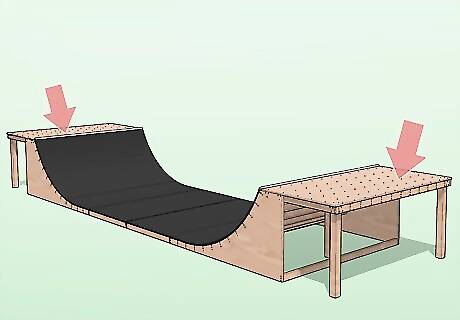
Construct platforms next to the transitions for a place to stand. The platforms are the raised sections on the back of each transition so you have a place to relax and drop in to the ramp. Frame boxes that are the same length as your transitions and surface them with plywood. Attach the platforms to the transitions so they butt up against the copings. Screw more boards or posts to the bottom of the platform to support the weight of the platform.
Creating the Transition Pieces

Draw lines on a plywood sheet 3 ⁄2 in (8.9 cm) in from the long edges. Get a 4 ft × 8 ft (1.2 m × 2.4 m) sheet of ⁄4 in (1.9 cm) plywood that’s made for exterior use. Measure 3 ⁄2 inches (8.9 cm) in from one of the long sides and make a mark. Lay a straightedge on the mark so it’s parallel to the long side and use it to draw a straight line across the entire length of plywood. Then measure in the same distance from the other long edge and make another line. The area between the lines will be the overall height of your halfpipe. If you want to make one that’s taller, you will need to use multiple sheets of plywood for a single side.

Make a dot on the first line 16 in (41 cm) in from the short edge. Go back to the first line you drew and measure in from the short side by 16 inches (41 cm). Use a pencil or marker to make a dot or X on the line so you know where to place your pencil later on. The dot marks where your transition will start curving up toward the platform.

Measure 6 ft (1.8 m) out from the dot so it’s perpendicular to the line. Put the end of your tape measure on the dot and extend it across the width of the plywood. Keep the tape measure parallel to the short edges of the plywood and perpendicular to the lines you drew. Pull the measuring tape out until it’s extended 6 feet (1.8 m). This means the horizontal distance from the front to the back of the transition is 6 feet (180 cm) and the ramp will have a gentle curve. You can always make the ramp steeper by decreasing the distance or gentler by increasing the distance, but avoid making it longer than the ramp’s height. Otherwise, you’ll have steep vertical sections that are very hard to ride on.

Stick a screwdriver in the ground at the measurement. Push the blade of the screwdriver into the soil right where the measurement reads 6 feet (1.8 m). Leave about 6 inches (15 cm) of the screwdriver above ground, but make sure it doesn’t wobble or shift around easily. You can also use a wooden stake in place of a screwdriver. If you’re working indoors or can’t put something in the ground, lay down a sheet of ⁄4 inch (1.9 cm) plywood and secure a screw on the measurement instead.

Tie the ends of a string to the screwdriver and a pencil. Cut a piece of string to 6 feet (1.8 m) long. Secure one end of the string to the blade of the screwdriver with an overhand knot so it doesn’t come loose. Pull the string tightly until you reach the dot on your sheet of plywood. Hold a pencil vertically on the dot and wrap the string around it. Always keep the string pulled tight, or else the string will be too long and screw up your measurements. If the screwdriver pulls out of the ground, put it back at your measurement and ask a helper to hold it in place.

Swing the pencil to the opposite corner to draw the curved section of ramp. Keep the pencil vertical as you move it across the piece of plywood. Pull the string tightly so you make a smooth, curved line, which is the part of the ramp that leads up to the platforms. When the curved line intersects the straight guide line on the opposite side of the plywood, stop drawing and lift up your pencil. If there are any wobbles in the curved line, erase them and try drawing it again until it looks smooth.

Cut along the outline with a jigsaw to make the first transition piece. Set the plywood on sawhorses so you don’t cut or damage anything. Line the jigsaw’s blade up with the line on the short edge of your board and start your saw. Slowly guide the saw along the outlines for the transition piece, making sure that the cut line doesn’t wobble or waver. Keep cutting until you reach the other short side of the plywood. Your transition piece will look like a trapezoid with one curved side. Wear safety glasses whenever you use a jigsaw just in case the wood kicks back. Keep your hands away from the saw’s blade since you could easily injure yourself.

Trace the first transition piece to make 3 more that are the same size. Flip the first transition piece upside-down and lay it on the leftover piece of plywood. Trace around the outline with a pencil to make your second transition. Repeat the process on another sheet of plywood and cut them out with your saw so you have 4 transition pieces that are all the same size when you’re finished.
Framing the Transitions
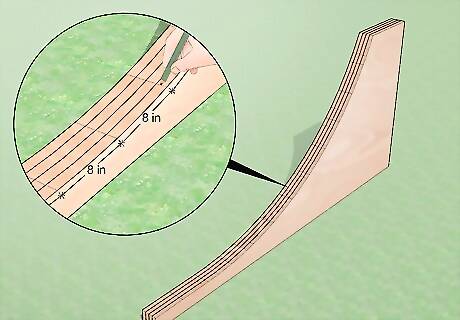
Mark every 8 in (20 cm) along the transitions’ curved edges. Hold all of the transition pieces together so their curved edges are flush. Bend a tape measure along the curve of the pieces and draw a line every 8 inches (20 cm). Work your way from the bottom of the curve toward the top section with the flat platform so you know where to put your supports. It’s okay if your last mark doesn’t line up with the top edge of the board.
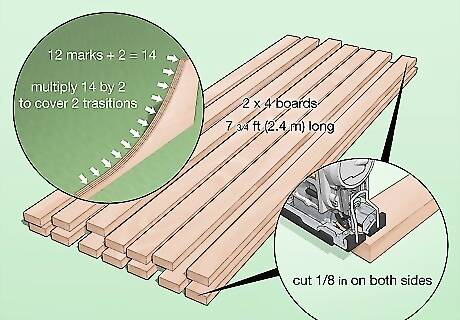
Cut boards to 7 ⁄4 ft (2.4 m) long for each mark on a transition. Count the number of marks you just made on 1 transition piece and add 2 for additional supports in the corners. Multiply the number by 2 to find the total number of boards you need for your transitions. Get 2 in × 4 in (0.051 m × 0.102 m) boards that are 8 feet (2.4 m) long and made for exterior use. Mark ⁄8 inch (0.32 cm) in from the short edges of each board. Use your jigsaw or a circular saw to cut the ends off of the boards so they’re square. For example, if you made 10 marks on a transition piece, you would need 12 boards to build one and 24 boards for both.

Screw the cut boards between the transitions’ bottom corners. Place one of your 7 ⁄4 ft (2.4 m) boards on its narrow end and position it between the front bottom corners of 2 transition pieces. Keep the board flush with the fronts of the transition pieces and the curved edge so the ramp doesn’t warp. Place 2–3 wood screws that are 1 ⁄2 inches (3.8 cm) long through the transition pieces into the ends of the board. Place another board between the back bottom corners and attach it the same way. Use the other 2 curved pieces and 2 more boards to construct another transition. The bottom boards will help ensure the transition pieces stay square so your halfpipe doesn’t get warped or crooked. Always try to work on a level surface when you’re building your ramp so you don’t attach pieces when they’re crooked.

Attach the cut boards to the transitions so they’re centered on your marks. Slide one of your cut boards between the transition pieces and line it up with the next mark from the bottom along the curved edge. Rotate the board so the narrow edge sits flush with the transition’s curve. Have a helper hold the board in place while you put 2–3 1 ⁄2 in (3.8 cm) screws into the ends of the board. Continue working your way up from the bottom, placing the center of the board on each mark until you reach the top of the transition. Avoid putting all of the boards with their widest side flush to the curve since they’re more likely to bend and won’t support your weight as well. When you reach the highest mark on your transitions, place the board so the wide, flat side lines up with the curve. This makes it easier to screw in the coping pipe later on.
Attaching the Flat Bottom
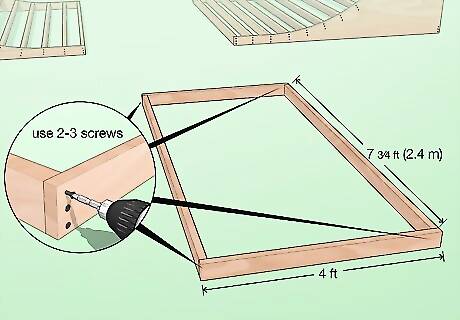
Make 2 wooden box frames that are 4 by 8 feet (1.2 m × 2.4 m). Lay a 2 in × 4 in (5.1 cm × 10.2 cm) board that’s 4 ft (1.2 m) long on it’s narrow edge. Position 2 of your 7 ⁄4 feet (2.4 m) boards so the wider sides are flush with the ends of your first board. Position another 4 ft (1.2 m) board so the ends are flush with the outside edges of the longer boards. Put 2–3 screws that are 1 ⁄2 inches (3.8 cm) long through the shorter boards so they go into the ends on the longer ones. Make a second frame the same way. Avoid making one large 8 by 8 feet (2.4 m × 2.4 m) frame since it won’t have the same amount of support.

Mark every 8 in (20 cm) along the long edges of your frames. Start your measuring tape on the short side of your frame and extend it 8 inches (20 cm) along the long side. Draw a mark on top of the board at your measurement. Work your way down one of the long sides of the frame before you start marking the other long edge. Make sure the marks that are across from one another line up so they’re parallel to the short edges.
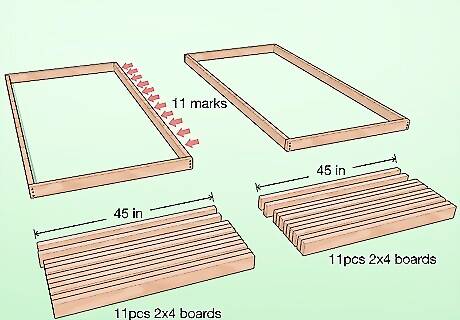
Cut boards to 45 in (1.1 m) lengths for each pair of marks. Count the number of marks on one long edge of your frame so you know how many boards you need for your frame. Get 2 in × 4 in (5.1 cm × 10.2 cm) boards that are 4 feet (1.2 m) long. Measure in 1 ⁄2 inches (3.8 cm) in from the ends of the board and mark it with a pencil. Use your jigsaw or a circular saw to cut along your marks so the ends of the board are square. These boards need to be smaller so they can fit in between the long edges of the frames.

Attach the cut boards between the marks on your frames. Slide one of the 45 in (1.1 m) boards into your frame so the marks are on center and the narrow edge faces up. Keep the top edge of the board flush with the edges of the frame. Put 2–3 wood screws into the ends of each board to secure them in place. Work on a level surface to ensure so don’t accidentally position the boards crooked.

Screw the 2 frames together on their long sides to make the flat bottom. Press the long edge of one frame against the long edge of the second frame and hold them together tightly. Use 1 ⁄2 in (3.8 cm) wood screws every 8 inches (20 cm) along the long edge, alternating which frame you start them from. When you’re finished, you’ll have an 8 by 8 feet (2.4 m × 2.4 m) flat bottom for your halfpipe.

Attach the transitions to the flat bottom with wood screws. Lay the flat bottom on a level surface where you plan to install the halfpipe. Move the transitions next to the edges of the flat bottom so all of the support boards run parallel. Push the transitions tight against the flat bottom so the edges are flush. Attach 3 in (7.6 cm) wood screws through the transitions and into the flat bottom every 1–2 feet (30–61 cm). If you don’t assemble the halfpipe on a level surface, then the ramp might get warped and you won’t be able to ride on it smoothly.
Surfacing Your Ramp

Put a layer of ⁄2 in (1.3 cm) plywood on the ramp’s flat section. Start the first 4 ft × 8 ft (1.2 m × 2.4 m) sheet of plywood so the long side lines up with where the flat bottom connects to a transition. Set another piece along the edge of the second transition so the plywood forms a tight seam in the middle of the halfpipe. Avoid using any thinner material when you first start surfacing your ramp since it won’t be able to support your weight.

Screw the plywood in every 1 ft (30 cm) along the supports. Press the plywood down tightly against the bottom frame so the edges stay flush. Measure in 1 ft (30 cm) from the edge of the frame and sink a 1 ⁄2 in (3.8 cm) wood screw into the support board. Continue across the length of the support to add more screws. Continue driving screws along the full length and width of the plywood sheets so there are at least 4 screws in every horizontal support board. Drive the screws far enough into the wood so the heads don’t stick out, or else you’ll have bumps in your riding surface.

Step on the plywood to secure it against the transitions. Lay a plywood sheet down against the curved edge of the transition and press down on it firmly with your foot. The plywood will bend into the shape of the curve so it stays flush with the transition pieces. Keep the plywood pressed against the transition as you screw it every 1 foot (30 cm) into the horizontal supports. Work from the flat bottom up toward the top of the transition so the wood doesn’t warp. If you can’t keep the plywood down by yourself, ask a helper to put their weight against it while you screw it in. You may also cut your plywood to 4 ft × 4 ft (1.2 m × 1.2 m) squares since it may be easier to work with smaller pieces.

Offset the second layer of plywood by about 8 inches (20 cm). Place another piece of plywood onto your halfpipe so the long edge is 8 inches (20 cm) in from the bottom of the transition. Press the plywood down and screw it into the supports with 1 ⁄2 inches (3.8 cm) wood screws. Position the screws at least 3–4 inches (7.6–10.2 cm) away from the screws in the first layer so they don’t get damaged. Cover the entire riding surface with your second layer of plywood. The second layer helps reinforce the ramp so it’s more durable and less likely to break.
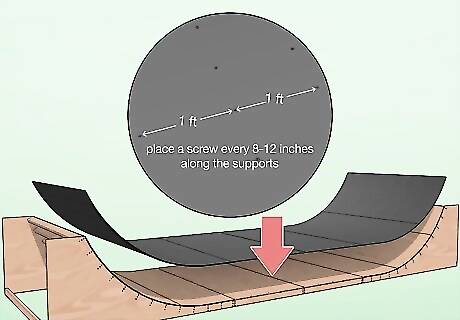
Put ⁄4 in (0.64 cm) ramp surfacing as your final layer. If you’re installing the ramp outside, use a specialty ramp surface like Skatelite or Ramp Armor since it’s durable and weatherproof. If you’ve made your ramp indoors, you can use ⁄4 in (0.64 cm) masonite. Lay the sheets of ramp surfacing on top of the plywood and screw it in along the supports with 1 ⁄2 in (3.8 cm) screws. Place your screws every 8–12 inches (20–30 cm) along the supports to hold them down securely. Specialty ramp surfacing can cost up to $200 USD for a 4 ft × 8 ft (1.2 m × 2.4 m) sheet and you can buy it online. Make sure the screw heads don’t stick above the surfacing, or else wheels can get caught on them and make your ride bumpier.
Adding the Coping

Drill ⁄8 in (9.5 mm) holes every 2 ft (61 cm) along 2 pipes. Get 2 PVC or metal pipes that’s 8 feet (2.4 m) long and has a 2 in (5.1 cm) circumference. Put a ⁄8 in (0.95 cm) metal-cutting drill bit into your drill. Make marks on the pipes every 2 feet (0.61 m) so you know where to place your holes. Hold the drill bit perpendicular to the pipe and slowly guide it through 1 side of the pipe. The pipes used for the copings make it easier to grind and do tricks along the top of your halfpipe.Warning: Avoid drilling through metal pipes with standard bits since they’re more likely to shatter and cause injuries.

Make ⁄16 in (4.8 mm) holes in the opposite side of the pipe. Rotate the pipe by 180 degrees so the holes you just drilled are on the bottom. Change your drill to a ⁄16 in (4.8 mm) bit and lock it in place. Mark holes every 2 feet (0.61 m) so they’re aligned with the holes on the bottom. Push your drill through each mark until you break through to the middle of the pipe. The larger holes in the pipe allow you to feed a drill bit through them and the smaller holes are where the screws will feed through.
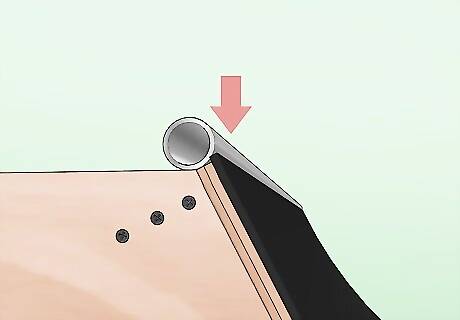
Set the copings into the top notches of the transitions so the ends are flush. The top corners of your transitions will have a small notch between the ramp’s surface and the top edge. Lift the coping pipe onto the transition and set it down in the notch so the smaller holes line up with the narrow edge of the top support board. Make sure the front of the coping sits flush with the ramp’s surface and the ends don’t extend past the sides of the transition. If the coping overhangs the ramp’s surface, use your jigsaw to cut the notch deeper.

Screw the copings into the top support boards of the transitions. Have a helper hold the coping pipe in place so it doesn’t move around. Place a 3 in (7.6 cm) wood screw on an extended screwdriver bit and carefully feed it through the larger hole in the top of the coping. Push the tip of the screw through the smaller hole on the bottom of the pipe. Drive the screw straight into the support board until the screw head is flush with the inside edge of the coping. Add screws to the rest of the holes in the copings to secure them to the transitions. Screw the copings in slowly so you don’t damage or split the support board underneath.
Assembling the Platforms

Build 2 wooden frames that are 8 by 4 feet (2.4 m × 1.2 m). Lay a 2 in × 4 in (5.1 cm × 10.2 cm) board that is 4 ft (1.2 m) long on it’s narrow side. Place 2 boards that are 7 ⁄4 feet (2.4 m) perpendicular to the shorter piece so the sides are flush. Place another 4 ft (1.2 m) board so it’s ends are flush with the outer edges of the long pieces. Screw the shorter boards into the ends of the longer boards with 3 inches (7.6 cm) wood screws to make your box frames. The frames will look similar to the frames you used on your flat bottom. You can adjust the platform to whatever width you want, but somewhere between 2–4 feet (61–122 cm) is usually standard for a beginner halfpipe.

Mark every 16 in (41 cm) along the frames’ long edges. Measure along the long side of your frame from the corner and make a mark at 8 inches (20 cm). Continue working down the length of the long board and add a new mark every 8 inches (20 cm). Then make marks on the other long board so they line up with the first ones you drew.
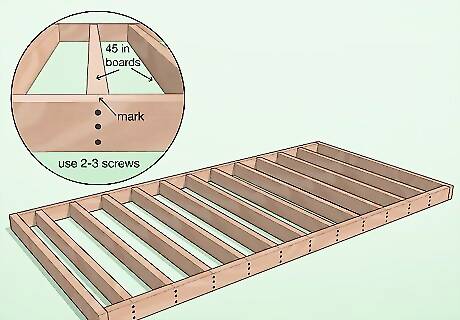
Secure 45 in (1.1 m) boards in the frames on your marks. Position a 2 in × 4 in (5.1 cm × 10.2 cm) board between the long side pieces so it’s on center with the marks you made and parallel to the short sides. Attach 2–3 wood screws that are 3 inches (7.6 cm) long through the long sides of the frame and into the support board. Work your way across the frames until you screw boards in between every set of marks. Make sure the narrow side of the board faces up when you install the supports so they can handle the most weight. Otherwise, they may bend or break.

Cover the platform frames with ⁄4 in (1.9 cm) plywood. Set a 4 ft × 8 ft (1.2 m × 2.4 m) sheet of plywood on top of the support boards so the edges are flush with your frame. Attach 1 ⁄2 in (3.8 cm) screws every 8 inches (20 cm) along each of the support boards and frame. Work from one short side to the other so the wood doesn’t warp or bubble in the middle. Avoid using plywood that’s any thinner, or else it may not be able to support your weight.

Attach 4 in × 4 in (10 cm × 10 cm) posts along the back of the platform. Measure the height of your transition so you know how tall to make your posts. Transfer your measurement onto a 4 in × 4 in (10 cm × 10 cm) post and cut 3 pieces that are the same height. Place 2 of the posts in the corners on the bottom of the platform and 1 along the back closest to the center support. Use 2–3 wood screws that are 3 inches (7.6 cm) long to attach the top of the platform to the posts. If you don’t want to buy posts, you can screw 2 2 in × 4 in (5.1 cm × 10.2 cm) boards together instead.

Screw the platforms into the sides of the transitions every 8 in (20 cm). Push the platforms into the backs of the transitions until the fronts are flush with the coping. Secure 1 ⁄2 in (3.8 cm) screws through the upper edge of the transition so they go into the sides of the platform. Put at least 2–3 screws every 8 inches (20 cm) so the platform stays stable on the transitions. Once you attach the platforms, you’re ready to ride! If the platforms still don’t feel sturdy when you stand on them, screw boards at a 45-degree angle from each leg so they connect to the bottom supports on the platform.



















Comments
0 comment